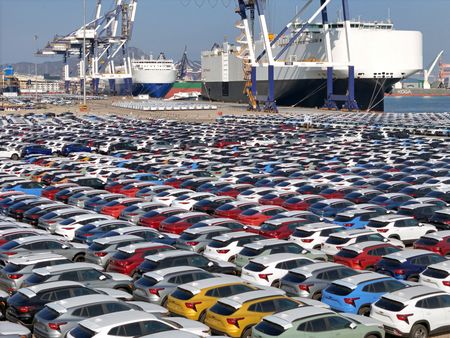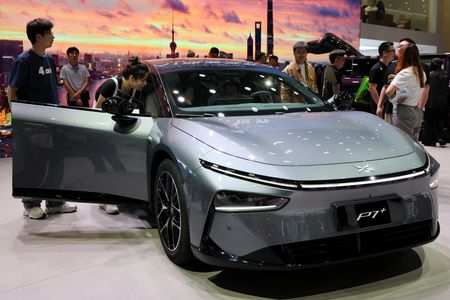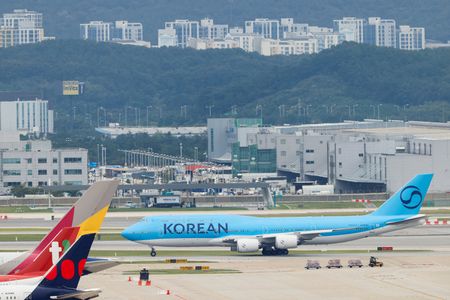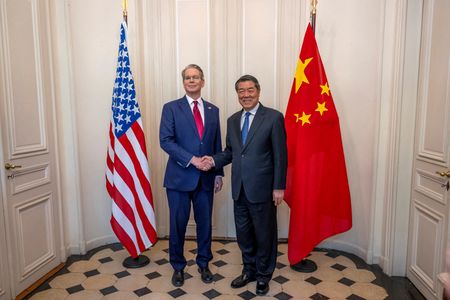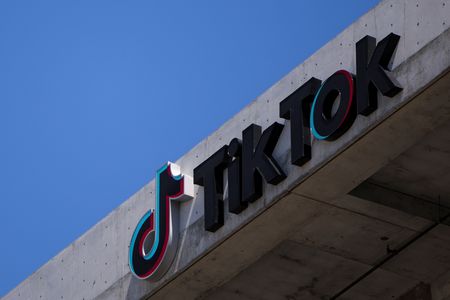By Joe Cash, Xiuhao Chen and Liz Lee
BEIJING (Reuters) – China on Thursday urged the United States to immediately cancel its latest tariffs and vowed countermeasures to safeguard its own interests, after President Donald Trump declared sweeping levies on U.S. trading partners around the world.
The U.S. move disregards the balance of interests reached in multilateral trade negotiations over the years and the fact that it has long benefited greatly from international trade, China’s Commerce Ministry said in a statement.
“China firmly opposes this and will take countermeasures to safeguard its own rights and interests,” the ministry said, as the world’s largest economies look set to spiral deeper into a trade war that stands to upend global supply chains.
Trump on Wednesday announced China would be hit with a 34% tariff, on top of the 20% he previously imposed earlier this year, bringing the total new levies to 54% and close to the 60% figure he had threatened while on the campaign trail.
Chinese exporters, like those from other economies around the world, will face a 10% baseline tariff, as part of the new 34% levy, on almost all goods shipped to the world’s largest consumer economy from Saturday before the remaining, higher “reciprocal tariffs” take effect from April 9.
The average U.S. tariff on Chinese goods will be 76%, according to Chad Brown, senior fellow at the Peterson Institute for International Economics and chief economist at the State Department for the last year of the Biden administration.
Trump also signed an executive order closing a trade loophole known as “de minimis” that has allowed low-value packages from China and Hong Kong to enter the U.S. duty free.
Trump had ordered the U.S. Trade Representative to determine whether China was living up to its commitments under the 2020 “Phase 1” U.S.-China trade agreement by April 1.
The deal required China to increase purchases of U.S. exports by $200 billion over a two-year period, but Beijing failed to meet its targets when the COVID-19 pandemic struck.
China bought $154 billion in U.S. goods in 2017, before the trade war began, Chinese customs data shows, and that figure rose to $164 billion last year.
WORLDWIDE TARIFFS
“Arguably, President Trump’s tariffs elsewhere will cause the most headaches,” said Ruby Osman, a China expert at the Tony Blair Institute for Global Change.
“Chinese firms have been rerouting trade through places like Vietnam and Mexico to avoid U.S. sanctions, but these markets are now being hit with significant tariffs of their own.”
“China+1” strategies caught on among Chinese exporters and multinational companies that had made the production powerhouse central to their supply chains during Trump’s first term.
But with India, Mexico, Vietnam and Malaysia – the countries that benefited most from this shift – facing tariffs of between 24% and 46%, the cost advantage of relocating manufacturing out of China is significantly diminished.
European Union Chamber of Commerce in China president Jens Eskelund said many companies had adjusted their supply chains specifically to limit their exposure to U.S.-China trade tensions and that “any subsequent restructuring of supply chains will not be possible overnight.”
The extra levies could encourage China to step up its trade with alternative markets, but no other country comes even close to U.S. consumption power, where Chinese producers sell more than $400 billion worth of goods annually.
“Trump’s tariffs certainly won’t help Chinese firms and will cause some real pain in some sectors, but they don’t make any definitive mark on the Chinese economy,” said William Hurst, Chong Hua Professor of Chinese Development at the University of Cambridge.
“U.S. exports are of declining importance to China. The American tariffs will spur more Chinese trade with other places, from Europe to Southeast Asia and Africa,” he added.
But Chinese producers have described shifting to alternative markets as a “rat race”, resulting in price wars among exporters that risk fanning deflationary forces in the world’s second-largest economy as firms continue to squeeze shrinking margins.
China has kept its economic target for this year unchanged at “around 5%” despite Trump’s tariff salvos which could halt a largely export-led recovery underway since the end of the COVID-19 pandemic.
The government has pledged more fiscal stimulus, increased debt issuance, further monetary easing and put an even greater emphasis on boosting domestic demand to cushion the impact of the trade war.
“China knew this day was coming well in advance, the relatively restrained stimulus announcements at March’s Two Sessions were a calculation, not an oversight,” Osman said, referring to China’s annual parliamentary meetings.
“Beijing has purposefully kept more in reserve, both in terms of domestic stimulus and retaliatory measures, in case it needs to respond more forcefully,” she added.
China’s President Xi Jinping might also enter the fray, following reports the two leaders could meet in June in the United States.
“Trump and Xi are locked in a paradox of pressure and pride,” said Craig Singleton, senior fellow at Washington-based research institute Foundation for Defense of Democracies.
“Trump’s strategy mixes maximum pressure with sudden diplomatic overtures — he sees leverage and engagement as complementary. Xi, by contrast, is methodical and risk-averse, relying on delay and discipline. But here’s the dilemma: if he refuses to engage, the pressure escalates; if he engages too soon, he risks looking weak,” he added.
“Neither wants to be seen as folding first, but delay could deepen the standoff.”
(Reporting by Liz Lee, Ella Cao, Jing Wang, Joe Cash, Shi Bu, Yukun Zhang, Qiaoyi Li, Ethan Wang and Xiuhao Chen; Writing by Joe Cash; Editing by Kim Coghill, Michael Perry, Lincoln Feast, Philippa Fletcher)

